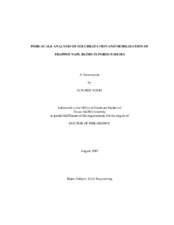| dc.description.abstract | NAPL (non-aqueous phase liquid) blob mobilization and solubilization models were developed to predict residual NAPL fate and describe flow dynamics of various displacing phases (water and surfactant foam). The models were achieved by pore-scale mass and force balances and were focused on the understanding of the physico-chemical interactions between NAPL blobs and the displacing phases. The pore-level mass balance indicated changes in NAPL saturation instead of mass reduction occurring with blob solubilization. The force balance was used to explain the complex flow configurations among NAPL blobs and the displacing phases. Some factors such as the wettability and the spreading/entering coefficients were useful in determining flow configurations. From the models developed in this study, dimensional analysis was performed to identify NAPL blob motion during water or surfactant foam flooding. In non-dimensionalized forms, a Trapping number employed as an indicator of blob displacement performance was modified to quantify the onset of blob mobilization. Its value for water flooding was nearly 2-3 orders of magnitude greater than that of surfactant foam flooding. Next, to investigate the blob flow regime in porous media, a blob velocity was computed. Regardless of the displacing phases, a blob’s velocity increased with increasing blob sizes after commencement of blob motion, and the velocity of DNAPL (dense non-aqueous phase liquid) blobs was greater than that of LNAPL (light non-aqueous phase liquid) blobs. From this investigation, it is expected that the pore-scale solubilization and mobilization models would provide better understanding leading to a predictive capability for the flow behavior of NAPL blobs removed by various displacing phases in a porous medium. Additionally, the models based on newly approached concepts and modified governing equations would be useful in conceptualization, as well as the model prediction of other immiscible or miscible fluids flowing through a porous medium. Further, the models developed in our study would be a useful contribution to the study of small-scale contaminants or substances such as particle and bacterial transport in porous media. | en |


